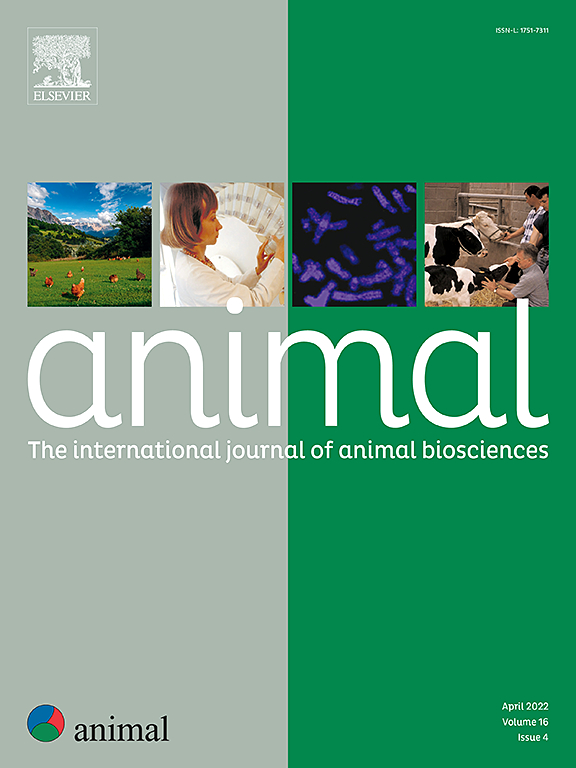通过改变猪圈设计和饲养策略来促进母猪-仔猪信息传递和有趣的觅食,以缓解断奶:对猪的生产性能和行为的影响
IF 4.2
2区 农林科学
Q1 AGRICULTURE, DAIRY & ANIMAL SCIENCE
引用次数: 0
摘要
受猪的自然行为启发的策略,包括向母猪学习和好玩的觅食,可能会减轻断奶仔猪的行为问题并提高它们的生产性能。我们采用2 × 2设计,研究了“家庭喂养系统”(Fs)和提供“家庭饲料”(Ff)的日粮处理对断奶后第35天的生产性能和行为的影响。将104头母猪和仔猪分别饲养在Fs和常规体系(Cs)中,分别饲喂Ff和不饲喂Ff (Cf)。6头母猪可以全天在仔猪可接近的盘子上获得饲料。仔猪和母猪也可以共同饮水和探索富集物质。在两个系统中,小猪喂食器是相同的,但在f中,它含有丰富的物质来刺激有趣的觅食。仔猪在27日龄断奶。Ff仔猪饲料从出生后第2天至断奶后第9天提供,含有人工香料和Ff母猪日粮中的几种成分,允许风味转移,并具有不同的颗粒大小和长度,以增加质地多样性。除仔猪饲料外,在断奶后4.5 d内饲喂母猪饲料。测定母猪和仔猪的生产性能、机体损伤、进食数量、断奶后行为和腹泻情况。出现肩部病变的f级母猪少于Cs级母猪。f组摄食比例、断奶前仔猪生长和断奶重较高。直到断奶后第9天,f仔猪的采食量较高,但生长较低,可能是由于这一时期腹泻发病率较高。断奶后第35天的体重不受系统影响。与Cs仔猪断奶前后相比,f组仔猪的耳尾损伤和机体损伤评分降低,断奶后咬耳和咬尾行为也有所减少。Ff不影响断奶前的生产性能,但增加了断奶后第9天的腹泻,第9天耳朵受损的仔猪比例和咬尾频率,对断奶后生长没有影响。f型仔猪断奶后摄入的母猪饲料和Ff型仔猪饲粮中使用的母猪饲粮成分可能在一定程度上解释了这些仔猪腹泻发生率高的原因,因此f型和Ff型仔猪对断奶后增重没有积极影响。综上所述,基于猪的自然行为的策略似乎有望提高仔猪断奶前后的福利,但需要进一步调整仔猪断奶后的营养需求。本文章由计算机程序翻译,如有差异,请以英文原文为准。
Promoting sow-piglet information transfer and playful foraging by changes in pen design and feeding strategy to ease weaning: effects on pig performance and behaviour
Strategies inspired by the natural behaviour of pigs, including learning from the sow and playful foraging, may alleviate behavioural problems in weanling piglets and enhance their performance. We investigated the effects of a ‘family feeding system’ (Fs) and a dietary treatment providing ‘family feeds’ (Ff) in a 2 × 2 design on performance and behaviour until day 35 postweaning. Sows (n = 104) and piglets were either kept in the Fs or in a conventional system (Cs), and fed either the Ff or not (Cf). Fs sows could obtain feed throughout the day provided on a plate accessible to the piglets. Piglets and sows could also jointly drink and explore enrichment materials. The piglet feeder was identical in both systems, but in the Fs, it contained enrichment materials to stimulate playful foraging. Piglets were weaned at 27 days of age. Ff piglet feed, offered from postnatal day 2 until day 9 postweaning, contained the artificial flavour and several ingredients of the Ff sow’s diet, allowing for flavour transfer, and had varying pellet size and length to increase texture diversity. Fs piglets were, apart from piglet feed, provided with sow feed for the first 4.5 postweaning days. Sow and piglet performance and body damage, number of eaters and postweaning behaviour and diarrhoea were determined. Less Fs than Cs sows had shoulder lesions. In the Fs, the proportion of eaters, preweaning piglet growth and weaning weight were higher. Until day 9 postweaning, Fs piglets’ feed intake was higher, but growth lower, possibly due to a higher incidence of diarrhoea in this period. BW at day 35 postweaning was unaffected by system. Ear and tail damage and body lesion scores were decreased in Fs compared to Cs piglets pre- and postweaning, along with ear and tail biting behaviour postweaning. The Ff did not affect preweaning performance, but increased postweaning diarrhoea until day 9, proportion of piglets with damaged ears on day 9 and tail biting frequency, with no effect on postweaning growth. The postweaning intake of sows’ feed in Fs piglets and the use of ingredients from the sows’ diet in the Ff piglet diet might partly explain the high incidence of diarrhoea in these piglets, and thereby the absence of positive effects of the Fs and Ff on postweaning gain. In conclusion, strategies based on the natural behaviour of pigs seem promising to enhance piglet welfare around weaning, but further adjustment to their postweaning nutritional needs is required.
求助全文
通过发布文献求助,成功后即可免费获取论文全文。
去求助
来源期刊

Animal
农林科学-奶制品与动物科学
CiteScore
7.50
自引率
2.80%
发文量
246
审稿时长
3 months
期刊介绍:
Editorial board
animal attracts the best research in animal biology and animal systems from across the spectrum of the agricultural, biomedical, and environmental sciences. It is the central element in an exciting collaboration between the British Society of Animal Science (BSAS), Institut National de la Recherche Agronomique (INRA) and the European Federation of Animal Science (EAAP) and represents a merging of three scientific journals: Animal Science; Animal Research; Reproduction, Nutrition, Development. animal publishes original cutting-edge research, ''hot'' topics and horizon-scanning reviews on animal-related aspects of the life sciences at the molecular, cellular, organ, whole animal and production system levels. The main subject areas include: breeding and genetics; nutrition; physiology and functional biology of systems; behaviour, health and welfare; farming systems, environmental impact and climate change; product quality, human health and well-being. Animal models and papers dealing with the integration of research between these topics and their impact on the environment and people are particularly welcome.
 求助内容:
求助内容: 应助结果提醒方式:
应助结果提醒方式:


